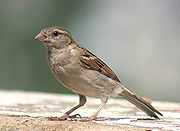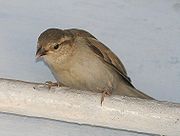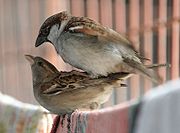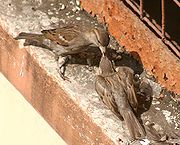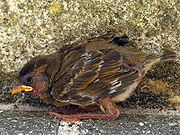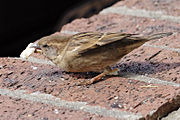
House Sparrow
Background to the schools Wikipedia
This content from Wikipedia has been selected by SOS Children for suitability in schools around the world. SOS Children works in 45 African countries; can you help a child in Africa?
{{Taxobox | name = House Sparrow | status = LC | image = House sparrowII.jpg | image_width = 250px | image_caption = Birdsong | regnum = Animalia | phylum = Chordata | classis = [[Bird|Aves] | ordo = Passeriformes | familia = Passeridae | genus = Passer | species = P. domesticus | binomial = Passer domesticus | binomial_authority = (Linnaeus, 1758) }}
The House Sparrow (Passer domesticus) is a member of the Old World sparrow family Passeridae, and is, somewhat controversially, considered a relative of the Weaver Finch Family. It occurs naturally in most of Europe and much of Asia. It has also followed humans all over the world and has been intentionally or accidentally introduced to most of the Americas, sub-Saharan Africa, New Zealand and Australia as well as urban areas in other parts of the world. It is now the most widely distributed wild bird on the planet. In the United States it is also colloquially known as the English Sparrow to distinguish it from native species.
Wherever people build, House Sparrows sooner or later come to share their abodes. Though described as tame and semi- domestic, neither is strictly true; humans provide food and home, not companionship. The House Sparrow remains wary of man.
Description
This 14 to 16 centimetre long bird is abundant in temperate climates, but not universally common; in many hilly districts it is scarce. In cities, towns and villages, even around isolated farms, it can be the most abundant bird.
The male House Sparrow has a grey crown, cheeks and underparts, black on the throat, upper breast and between the bill and eyes. The bill in summer is blue-black, and the legs are brown. In winter the plumage is dulled by pale edgings, and the bill is yellowish brown. The female has no black on head or throat, nor a grey crown; her upperparts are streaked with brown. The juveniles are deeper brown, and the white is replaced by buff; the beak is dull yellow. The House Sparrow is often confused with the smaller and slimmer Tree Sparrow, which, however, has a chestnut and not grey crown, two distinct wing bars, and a black patch on each cheek.
The House Sparrow is gregarious at all seasons in its nesting colonies, when feeding and in communal roosts.
Although the Sparrows' young are fed on the larvae of insects, often destructive species, this species eats seeds, including grain where it is available.
In spring, flowers — especially those with yellow colours — are often eaten; crocuses, primroses and aconites seem to attract the house sparrow most. The bird will also hunt butterflies.
The Sparrow's most common call is a short and incessant chirp. It also has a double call note phillip which originated the now obsolete name of "phillip sparrow". While the young are in their nests, the older birds utter a long churr. At least three broods are reared in the season.
The common, but declining House Sparrow was surprisingly the most common garden bird in 2006, calculated by the Royal Society for the Protection of Birds (RSPB)
Nesting
The nesting site is varied; under eaves, in holes in masonry or rocks, in ivy or creepers on houses or banks, on the sea-cliffs, or in bushes in bays and inlets. When built in holes or ivy, the nest is an untidy litter of straw and rubbish, abundantly filled with feathers. Large, well-constructed domed nests are often built when the bird nests in trees or shrubs, especially in rural areas.
The House Sparrow is quite aggressive in usurping the nesting sites of other birds, often forcibly evicting the previous occupants, and sometimes even building a new nest directly on top of another active nest with live nestlings. House Martins, Bluebirds, and Sand Martins are especially susceptible to this behaviour. However, though this tendency has occasionally been observed in its native habitats (particularly concerning House Martins), it appears to be far more common in habitats in which it has been introduced, such as North America.
Five to six eggs, profusely dusted, speckled or blotched with black, brown or ash-grey on a blue-tinted or creamy white ground, are usual types of the very variable eggs. They are variable in size and shape as well as markings. Eggs are incubated by the female. The House Sparrow has the shortest incubation period of all the birds: 10-12 days and a female can lay 25 eggs a summer in New England.
House Sparrows in Europe
In large parts of Europe, populations of House Sparrows are decreasing. In the Netherlands, the House Sparrow is even considered an endangered species, and the population of House Sparrows has dropped in half since the 1980s. It is however still the second most common breeding bird in the Netherlands, after the Blackbird. Currently the number of breeding pairs is estimated between half a million and one million. Similar precipitous drops in population have also been recorded in the United Kingdom.
Various causes for its dramatic decrease in population have been proposed, one of the more surprising being the introduction of unleaded petrol, the combustion of which produces compounds such as methyl nitrite , a compound highly toxic for small insects, which form major part of young sparrows diet. Other theories consider reducing areas of free growing weeds, or reducing numbers of badly maintained buildings, which are important nesting opportunities for sparrows.
House Sparrows as an invasive species
House Sparrows in Australia
House sparrows were introduced to Australia between 1863 and 1870. They were released first in Victoria and then to other areas including Sydney, Brisbane, and Hobart. They quickly became a major pest throughout eastern Australia, but have been prevented from establishing themselves in Western Australia where every found specimen is deliberately destroyed.
House Sparrows in North America
The large North American population is descended from birds deliberately imported from Britain in the late 19th century. They were introduced independently in a number of American cities in the years between 1850 and 1875 as a means of pest control. The mistake was realized after they were well established and by 1883 they were already considered pests and their introduction a disaster.
While declining somewhat in their adopted homeland, House Sparrows are one of the most abundant birds in North America, with a population estimated at approximately 150 million.
In the United States and Canada, the House Sparrow is one of only three birds (the other two being the European Starling and the Rock Pigeon) not protected by law. As an invasive non-indigenous species, it is legal to kill House Sparrows and destroy their eggs at any time in most places in the United States. These three introduced species are now each more widespread and common on the continent than are any other birds. House Sparrows kill adult bluebirds and other native cavity nesters and their young, smash their eggs, and take over their nesting sites, and as such are major factors in the decline of bluebirds and other native cavity nesters in North America.
Because the House Sparrow is smaller than the less aggressive native birds with which it competes, it is impossible to keep them out of nest boxes built for many native birds. Attempts to counter the effects of the House Sparrow on native bird populations include the trapping and shooting of adults and the destruction of their nests and eggs.


